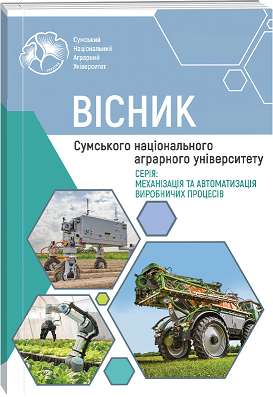DEVELOPMENT OF «CACCIOTTA» CRAFT CHEESE WITH INCREASED BIOLOGICAL VALUE
Abstract
Craft cheese production is a unique approach that combines tradition and innovation to create high-quality products. The use of powders and extracts from plant raw materials to enrich cheeses with vitamins, mineral and phenolic compounds that increase the functional and antioxidant properties of finished products is becoming relevant. The use of plants in cheese making is a long-standing practice, but it is usually related to local traditions and is mainly used to give cheese a special flavour or aroma or to increase shelf life. The aim of the work is to develop a technology of Kraft cheese «Caciotta» with increased biological value. To achieve this goal, the influence of lavender and milk extract of grape pomace on the quality parameters of cheese «Caciotta» was determined. As the main raw material used cow's milk, meeting the requirements of DSTU 3662:2018. As an enrichment agent – milk and vegetable extract from grape pomace (obtained according to utility model UA № 151760) in the amount of 15%, infrared dried lavender seeds in the amount of 3%. Lavender was used as an affinage. Standard methods of research were used in the work. As a result of organoleptic evaluation, it was determined that the introduction of milk and vegetable extract from grape extracts in the milk mixture cheese dough, respectively, and cheese on the cut acquires a light maroon colour with a purple tint, especially on the crust of the cheese. It is noted that the taste of the cheese is characterised as mild, slightly sweet-tart taste, smell – with light floral and grape notes, giving it an unusual and interesting aroma. Made cheese has a high content of protein (25.5%), fat (45.5%). A high content of flavonoids (35.35 mg/100g) was noted. The presence of phenolic compounds in cheese affects its taste, making it astringent and rich. In addition, phenolic compounds have anti-inflammatory, antimicrobial, antioxidant effects and are involved in redox processes. The moisture value corresponds to this type of cheese. In the work the technological scheme of production of Kraft cheese «Caciotta» with increased biological value is developed.
References
2. Al-Obaidi, L.F.H. (2019). Effect of adding different concentrations of turmeric powder on the chemical composition, oxidative stability and microbiology of the soft cheese. Plant Arch. 19, 317–321.
3. Aun, M.V., Mafra, C., Philippi, J.C., Kalil, J., Agondi, R.C., & Motta, A.A. (2011). Aditivos em alimentos. Rev. Bras. Alerg. Imunopatol, 34, 177–186.
4. Awda, J.M., Awad, H.A., Alssirag, M.A., & Alfalahi, D.A. (2019). Extend the shelf life and improving sensory properties of white soft cheese by adding celery. leaves. IRAQI J. Agric. Sci. 50, 1661–1667.
5. Evstigneeva, T., Skvortsova, N., Yakovleva, R. (2016). The application of green tea extract as a source of antioxidants in the processing of dairy products. Agron. Res. 14, 1284–1298.
6. Hussain, S.A., Panjagari, N.R., Singh, R.R.B., & Patil, G.R. (2015). Potential herbs and herbal nutraceuticals: Food applications and their interactions with food components. Crit. Rev. Food Sci. Nutr., 55, 94–122.
7. Laranjo, M., Fernández-León, A.M., Agulheiro-Santos, A.C., Potes, M.E., & Elias, M. (2019). Essential oils of aromatic and medicinal plants play a role in food safety. J. Food Process Preserv, e14278.
8. Mahajan, D., Bhat, Z.F., & Kumar, S. (2016). Pine needles (Cedrus deodara (Roxb.) Loud.) extract as a novel preservative in cheese. Food Packag. Shelf Life, 7, 20–25.
9. Odintsov, S. M., Nazarenko, Yu. V., Bolhova, N. V., Synenko, T. P., & Puryhin, I. O. (2024). Vykorystannia roslynnoi bilkovovmisnoiu syrovyny v tekhnolohii syriv [Use of vegetable protein-containing raw materials in cheese technology]. Tavrian Scientific Bulletin. Series: Technical sciences, (6), 139-146. https://doi.org/10.32782/tnv-tech.2023.6.16
10. Ritota, M., Mattera, M., Di Costanzo, M.G., & Manzi, P. (2018). Evaluation of Crocins in Cheeses Made with Saffron by UHPLC. J. Braz. Chem. Soc. 29, 248–257.
11. Selim, S. (2011). Antimicrobial activity of essential oils against Vancomycin-Resistant enterococci (VRE) and Escherichia coli O157: H7 in feta soft cheese and minced beef meat. Braz. J. Microbiol., 42, 187–196.
12. Semko, T., Palamarchuk, V., Ivanishcheva, O., Vasylyshyna, O., Andrusenko, N., Liliia, K., & Solomon, A. (2022). The production of the innovative craft cheese" Anchan". Slovak Journal of Food Sciences, 16. https://doi.org/10.5219/1778
13. Synenko, T. P. (2022) Rozrobka naturalnykh smako-aromatychnykh dobavok iz vtorynnoi syrovyny [Development of natural flavouring additives from secondary raw materials]. [Dissertation for the degree of Doctor of Philosophy in speciality: 181 ‘Food Technologies’]. Sumy National Agrarian University.
14. Synenko, T. P., & Frolova, N. E. (2022). Sposib oderzhannia molochno-roslynnoho ekstraktu iz vynohradnykh vychavkiv (Patent Ukrainy № 151760) [Method for obtaining milk-plant extract from grape pomace (Patent of Ukraine No. 151760)]. Derzhavna sluzhba intelektualnoi vlasnosti Ukrainy
15. Synenko, T.P., & Frolova, N.E. (2020). Vykorystannia vynohradnykh vychavok v tekhnolohii smakoaromatychnykh dobavok [The use of grape pomace in the technology of flavour additives.]. Materialy IKh Vseukrainskoi naukovo-praktychnoi konferentsii «Innovatsiini tekhnolohii v hotelno-restorannomu biznesi, 207–208.

 ISSN
ISSN  ISSN
ISSN 



